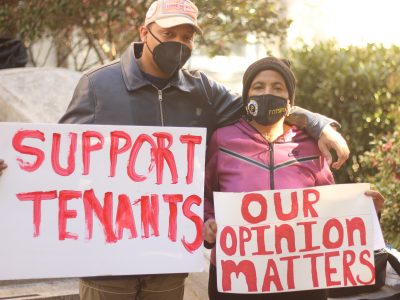by Jordan Green
A survey on food hardship completed by High Point University echoes the findings of a national survey that ranked the Greensboro-High Point metro area No. 1 in the country for food hardship. Food justice advocates in High Point and Greensboro are hoping that more refined local data will help them focus their efforts more effectively.
Joe Blosser, the director of service learning at High Point University and a member of the planning team at the Greater High Point Food Alliance, has encountered a lot of people who don’t believe it’s possible that the Greensboro-High Point metro area has the highest level of food hardship in the United States.
The finding came out of a poll by the Gallup organization that was published by the Washington-based Food Research and Action Center 12 months ago.
“From the work that I do, working with the community partners and working with the students, we’ve seen skepticism towards the numbers because a lot of people don’t see food hardship as part of their daily lives,” Blosser said. “It’s possible to live in Guilford County and not see poverty.
“In High Point, if you take a left or a right off Main Street you don’t have to go very far to see poverty in the community,” he added.
A new survey conducted by High Point University in early April and published by the university last week seems to confirm the findings of the nationwide survey published a year ago by the Food Research and Action Center, Blosser said. The High Point University researchers asked the same question to adults with landlines or cell phones representing 776 households in High Point and the surrounding communities of Jamestown, Archdale and Trinity as their national counterparts at Gallup: “Have there been times in the past 12 months when you did not have enough money to buy food that you or your family needed?”
The Greensboro-High Point metro’s No. 1 ranking for food hardship came from a finding by Gallup that 27.9 percent of respondents said that at some time in the past year they had not had enough money to buy the food their families needed. The High Point University researchers found that 23 percent of respondents answered yes to the same question.
Blosser said he considers the difference between the two figures to be within “the margin of error.”
The findings also provide a good indication that hunger is not limited to High Point, the smaller of the two cities in the metro area, Blosser said.
“High Point probably seems on par with Greensboro,” Blosser said. “The data didn’t come back that High Point was 40 percent, so Greensboro must be less. It validates the people in Greensboro to say it’s a problem across the county. We’re not bringing down the averages.”
A notable disparity that didn’t surprise Blosser and others in the Greater High Point Food Alliance at all emerged among the three ZIP codes that cover High Point. In the city’s poorest ZIP code, 27260 — cutting a diagonal swath from northeast to southwest through the heart of the city — 48 percent of respondents answered yes to the question about not having enough money sometime in the past 12 months to buy the food their families needed. In 27262, which covers the west side of the city including the affluent Emerywood neighborhood, the percentage was 26 percent, while in 26265 on the prosperous north side, the figure was 14 percent.
Blosser said the food alliance was already targeting much of its efforts to 26260, where most of the city’s food deserts are located.
The Guilford Food Council and the Greensboro Community Food Task Force are developing a similar study for Greensboro. Marianne LeGreco, an associate professor at UNCG, said the “community-based measure for food hardship” will be conducted by the Center for Housing and Community Studies, an outfit led by assistant sociology professor Stephen Sills.
LeGreco said she thinks the Gallup poll published by the Food Research Action Center was of limited use in that it only asked one question. She added, “It turned our attention that there might be a problem, but it doesn’t help us make decisions.”
The two city-based hunger studies, along with a community health assessment by Guilford County and the Cone Health Foundation that is currently underway, hold more promise, LeGreco said.
“We can triangulate the data, so we can look at it from multiple directions,” she said.
The High Point University survey drilled down to more specific questions for respondents who indicated they had not had enough money to buy the food they needed for their families sometime in the past 12 months. In one instance, respondents were read the statement, “The food that I/we bought just didn’t last, and I/we didn’t have money to get more,” and then asked to say whether that was “often,” “sometimes” or never true.”
Seven percent of respondents said that was often true, while 17 percent said it was sometimes true.
Another statement read, “I/we couldn’t afford to eat balanced meals.”
Nine percent of respondents said that statement was often true, while 15 percent said it was sometimes true.
The survey found that 18 percent of respondents said they ate less than they felt they should have because there wasn’t enough money for food sometime in the past 12 months, while 12 percent said they didn’t eat even though they were hungry.
Blosser said in some ways the High Point University survey only raises more questions. Only eight out of 771 — or 1 percent — respondents said they had received backpacks filled with food, so it’s hard for activists to get a sense of how long the food lasts and how significant an impact it makes on the families that are the beneficiaries.
“Backpacks are a big deal in Guilford County,” Blosser said. “There are lots of programs that are sending backpacks of food home with kids. But we don’t really have enough respondents to say they were getting backpacks to get a solid answer. We need to go into schools.
“We hear a lot about backpacks,” he continued. “But it’s only hitting 1 percent of households that are experiencing food hardship. But not all those households have children. So we’d like to see what percentage of households with food hardship that have children are getting the backpacks.”
The food alliance held its second food summit in March. Blosser said he considers the organization’s first year to be a success because people who operate different projects like food pantries and backpack programs are now talking to each other. The alliance has launched a High Point food finder app with information about emergency assistance, food pantries, community gardens and hot meals, along with information about ways to donate money and volunteer.
Going into its second year, Blosser said he expects the food alliance to focus more on offering cooking classes and helping people to establish community gardens.
Join the First Amendment Society, a membership that goes directly to funding TCB‘s newsroom.
We believe that reporting can save the world.
The TCB First Amendment Society recognizes the vital role of a free, unfettered press with a bundling of local experiences designed to build community, and unique engagements with our newsroom that will help you understand, and shape, local journalism’s critical role in uplifting the people in our cities.
All revenue goes directly into the newsroom as reporters’ salaries and freelance commissions.





From FRAC report:
Greensboro‐High Point, NC 27.9 1
Baton Rouge, LA 24.9 2
Fresno, CA 24.9 2
Bakersfield, CA 24.3 4
Jackson, MS 22.9 5
Augusta‐Richmond County, GA‐SC 22.8 6
Columbia, SC 22.8 6
Memphis, TN‐MS‐AR 22.7 8
Dayton, OH 22.6 9
Riverside‐San Bernardino‐Ontario, CA 22.4 10
Little Rock‐N Little Rock‐Conway, AR 22.1 11
Greenville‐Mauldin‐Easley, SC 22.0 12
Chattanooga, TN‐GA 21.7 13
New Orleans‐Metairie‐Kenner, LA 21.7 13
Louisville‐Jefferson County, KY‐IN 21.4 15
Deltona‐Daytona Beach‐Ormond Beach, FL 21.3 16
San Antonio, TX 21.3 16
Cape Coral‐Fort Myers, FL 21.0 18
Oklahoma City, OK 21.0 18
Pensacola‐Ferry Pass‐Brent, FL 21.0 18
Notice the complete lack of the many many small communities that we all know about experiencing real poverty problems but apparently lacking local money to be milked by such orgs and their offshoots.
Where are all of the Appalachia and Mississippi , the American Indian nations, and so numerous other truly broken areas listed?
This org has an agenda and while hardship may exist in pockets here surveys asking “how much more do you want somebody else to do for you” will get the desired results, every time.
Bettin’ their “non profit” leadership lives pretty well, too.
Think about that next time you see a govt issued card paying for a meal at Chili’s, not an economical use of funds,and guaranteed you won’t see in the real poverty pockets of our country.
Not sayin’ they can’t do some good, but such studies can come with a predetermined goal different than the noble work put out for view by the well meaning but susceptible.